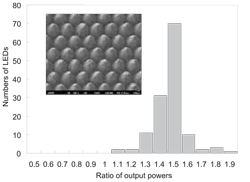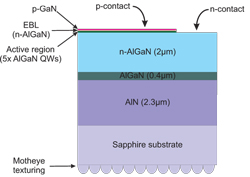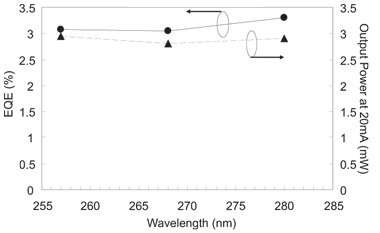
| Home | About Us | Contribute | Bookstore | Advertising | Subscribe for Free NOW! |
| News Archive | Features | Events | Recruitment | Directory |
News
14 June 2010
Deep UV LED efficiency reaches 3%
Researchers based in Nagoya, Japan have reported deep ultraviolet (255–280nm wavelength) LEDs with external quantum efficiencies (EQEs) of up to 3% [Cyril Pernot et al, Appl. Phys. Express, vol3, p061004, 2010]. The output power was up to 1mW at 10mA. The researchers “predict that an EQE of 5% for UV-C (280–100nm) single-chip LEDs is within reach.”
 Figure 1: Histogram of light output power ratios for 270nm LEDs with and without moth-eye structure. Inset: scanning electron micrograph (SEM) of moth-eye structure fabricated on back-side of sapphire substrate.
Figure 1: Histogram of light output power ratios for 270nm LEDs with and without moth-eye structure. Inset: scanning electron micrograph (SEM) of moth-eye structure fabricated on back-side of sapphire substrate.
The achievements were based on improvements of about 1.5x in extraction efficiency through using sapphire substrates with ‘moth-eye’ structuring (Figure 1) on their back-side (i.e. away from the active nitride semiconductor layers). Such structures have been used (by the same research group) for blue LEDs with silicon carbide substrates to boost light extraction.
The researchers – from UV Craftory Co Ltd, Meijo University, EL-SEED Corp, and Nagoya University – see applications in replacing mercury lamps with alternatives that are more compact, efficient, safer (no mercury) and versatile (with a wavelength ranging between 360nm and 200nm, rather than single wavelengths, determined by the mercury emission line spectrum, at 184nm, 254nm, 365nm . . .).
Systems using DUV LEDs are being developed for sterilization, water purification and surface disinfection. Other applications include curing of materials such as adhesives, spectrometry, medical therapies and currency validation.
The leading material system for LEDs in this wavelength range is aluminum gallium nitride (AlGaN), with energy bandgaps up to 6.2eV (i.e. wavelengths down to ~200nm) for pure AlN. However, as the target wavelength gets shorter, it becomes more difficult to produce high-efficiency devices. In particular, for the wavelength range below 280nm, external quantum efficiencies have been less than 2% up to now.
One major restriction on UV LED development is the p-type contact. The Al-content (if any) of the p-AlGaN layer has to be kept small for reasonable activation (already less than ideal in pure GaN) of the magnesium doping that is used. However, the AlGaN energy bandgap at these low Al-contents is narrower than the target wavelength and hence the p-contact is highly absorbing of the UV emitted by the active region. Developers of DUV devices are therefore forced to extract light mainly in the opposite direction, through the substrate. This is achieved through flip-chip packaging arrangements.
Although the n-type doping achieved by silicon doping can be carried out acceptably with higher-Al-content AlGaN, the material is more resistive, making heat generation a greater problem compared with longer-wavelength devices. Thermal management is therefore also important in achieving acceptable device performance.
 Figure 2: Deep UV LED epi structure with moth-eye structure on sapphire substrate.
Figure 2: Deep UV LED epi structure with moth-eye structure on sapphire substrate.
The devices were grown using metal-organic chemical vapor deposition with trimethyl-metal and ammonia sources (Figure 2). The Al-content of the AlGaN quantum wells controlled the emission wavelength (40%, ~280nm; 57%, 255nm). A p-AlGaN electron-blocking layer (EBL) was used to prevent electron overshoot into the p-type contact region.
The LEDs consisted of 800μm x 800μm mesas with nickel alloy and gold bonding pads for the p-contact and aluminum alloy and gold bonding pads for the n-contact. The chips were flipped onto thermally conductive AlN submounts. The mounted devices were installed in TO5 transistor outline packages.
Pulsed (10Hz, 20% duty cycle) and continuous wave (CW) operation were used to evaluate the devices. A 257nm device had a turn-on voltage of 5.5V and a forward voltage of 6.3V at 20mA. At this injection current, the full-width half-maximum (FWHM) value of the spectral peak was 10nm. The output power at 20mA was more than 2.8mW and the maximum EQE was 3% for all the devices studied (Figure 3). The peak wall-plug efficiency is estimated to be 2.2%. Output of10mW was achieved at 66mA and 1mW at 8mA.

Figure 3: Maximum EQE and output power at 20mA for 257, 268, and 280nm LEDs.
Self-heating effects tend to degrade the LED performance in CW operation at high currents. For the 257nm device, the output power was more than 1mW at 10mA (CW) without a heat-sink.
“The improved n-AlGaN quality allowed us to achieve these results, which are, to the best of our knowledge, the best reported to date for single-chip UV-C devices,” comment the researchers.
The improved n-AlGaN was achieved through depositing it on the thick AlN layer that was grown at high temperature on the initial sapphire substrate.
The effect of the moth-eye structuring of the sapphire substrate on light extraction was evaluated by producing 270nm devices with and with-out the patterning (Figure 1), and a 1.5-fold improvement was seen. The improvement is lower than for blue LEDs because the DUV light cannot undergo multiple reflections in the p-contact region, the researchers believe. The team wants to optimize the moth-eye structure for DUV emission in future work.
The researchers also performed reliability studies – at 10mA (CW), the output power was maintained at more than 75% of its initial value for 300 hours. This value is expected to be lengthened by improving the heat management of the devices through package optimization.
Correction: The corresponding author of the paper reported above, Cyril Pernot, responds to the story: "Our DUV LEDs reach 3% even when we do not use moth-eye sapphire. LEDs with moth-eye sapphire were not packaged but we expect that they can reach EQE close to 5% (1.5x the value of the LED without moth-eye).”
See related items:
Large chip improvements to deep-ultraviolet output power
First demonstration of semipolar III–nitride ‘deep-UV’ LED
Nichia achieves 2.78% external quantum efficiency for 281nm UV-LED
Dowa presents 320–350nm UV LED samples
Increased UV power from diamond LEDs enables E. coli sterilization
Multi-quantum blocking raises deep-UV LED efficiency
Improving deep UV emission on aluminum nitride templates
![]() Search: Deep UV LEDs Sapphire substrates AlGaN
Search: Deep UV LEDs Sapphire substrates AlGaN
Visit: http://apex.ipap.jp/link?APEX/3/061004
Visit: http://uvcr.jp/uvc/index.htm
The author Mike Cooke is a freelance technology journalist who has worked in the semiconductor and advanced technology sectors since 1997.